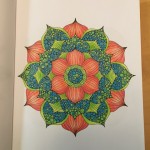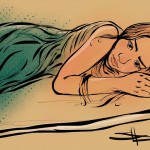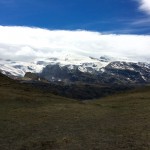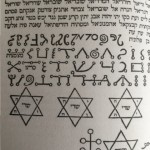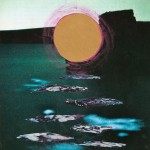A few years ago, I attended a contemplative Rosh Hashanah service. Overall it was beautiful: lots of chanting and meditation, none of the rote prayers I’d encountered at other temples. I was several years into my long hiatus from Witchcraft–a hiatus I thought was permanent–and I began to wonder if I’d perhaps finally found a spiritual community I’d feel comfortable in. But my hopes were dashed when it came time for the Torah service.
When the Torah scroll was taken from the ark, the congregation didn’t just kiss it as others do. They put on music and danced with it. The facilitator handed it off to one congregant at a time, and everyone had a chance to cradle it in their arms and twirl. I looked on, suddenly uncomfortable. Every Jew knows the famous Hillel quote: “That which is despicable to you, do not do to your fellows; that is the whole Torah, the rest is commentary.” And yet every time I opened to a random page of my little copy of the Tanakh, I encountered violence, misogyny, and divinely sanctioned aggression. Of course it’s accepted that we don’t read the Torah literally, but even the most radical interpretations left me wondering how much one can reinterpret a text before admitting that that text simply isn’t useful. To dance with the Torah scroll seemed to be an unmitigated expression of joy at its contents–and I didn’t feel that joy. The Torah contains a lot of wisdom and beauty, yes. But so much of it fills me with anger and sadness. So much of Judaism makes me feel like an outsider.
I hoped only volunteers would dance with the Torah, but the facilitator made sure that every single person got a turn. Suddenly, the scroll was thrust into my hands. I froze. The facilitator tried to get me to dance, but after I stood there petrified for a few moments, she took it away and moved on. The woman next to me leaned over. “That was the Torah,” she whispered. My face burned.
That was my last attempt to really engage in a synagogue service. Sure, I’ve attended a High Holy Day service here and there out of a vague sense of obligation, but the day I was expected to dance with the Torah was the day I more or less checked out.
Until I found the Kohenet Institute.
The priestesses at the Institute
revive and re-embody Judaism through the gifts of women spiritual leaders and through experience of the sacred feminine, whom we call Shekhinah, Goddess, and many other names. We teach the history of women as facilitators of spiritual experience. Our training programs for Jewish women committed to ritual as a transformative force impact the Jewish and wider community through our ritual programming and resources, and through our students’ work.
After my visit to the contemplative shul, I’d begun to practice secular Buddhism and had eventually found my way back to Witchcraft. But I hated feeling like I had to choose between my heritage and a fulfilling spiritual practice. The moment I found out what Kohenet was and what its graduates do–everything from officiating weddings to sewing amulets–I knew I’d found the fusion I was looking for.
Unfortunately, you can’t just stroll down to the local Kohenet group and hop in. The Institute is tiny, with less than 30 ordinees since its inception in 2006, and the trainings happen at retreat centers far from the urban areas where most Jews live. For almost three years I yearned to apply, but with a young child, a full-time job, and several hundred miles to travel, it just wasn’t feasible.
Which is why The Hebrew Priestess, a new book that encapsulates the Institute’s core teachings, is such a gift.
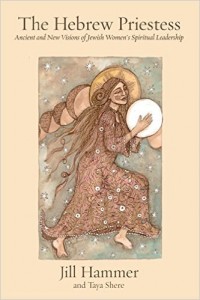 Starting from the premise that a priestess “tends the relationship between human and divine” (1), The book outlines the 13 “priestess paths” taught at the Institute: Weaver, Prophetess, Shrinekeeper, Witch, Maiden, Mother, Queen, Midwife, Wise-Woman, Mourning-Woman, Seeker, Lover, and Fool. Each chapter starts with the history and theory behind each path, and ends with a trance journey and suggestions for modern practice. The authors and founders of the Institute, Rabbi Jill Hammer and Taya Shere, each demonstrate their remarkable strengths: Hammer is a gifted scholar and thealogian, pulling the buried vestiges of priestesshood from scripture and history, and Shere’s exercises and prayer practices are simple and accessible, yet deeply transformative. For example, Hammer’s section in the chapter on the Weaver describes the women who wove curtains for the Tabernacle, and also touches on the Canaanite goddess Asherah as a goddess of weaving. Shere then discusses the practices of literal weaving and “weaving” structured prayers. The chapter on the Witch was also satisfying: as a tarot reader, I literally hugged the book after reading Shere’s tips for effective divination. For the first time in my life, I saw myself reflected in a Jewish text, and the experience was as startling as it was moving.
Starting from the premise that a priestess “tends the relationship between human and divine” (1), The book outlines the 13 “priestess paths” taught at the Institute: Weaver, Prophetess, Shrinekeeper, Witch, Maiden, Mother, Queen, Midwife, Wise-Woman, Mourning-Woman, Seeker, Lover, and Fool. Each chapter starts with the history and theory behind each path, and ends with a trance journey and suggestions for modern practice. The authors and founders of the Institute, Rabbi Jill Hammer and Taya Shere, each demonstrate their remarkable strengths: Hammer is a gifted scholar and thealogian, pulling the buried vestiges of priestesshood from scripture and history, and Shere’s exercises and prayer practices are simple and accessible, yet deeply transformative. For example, Hammer’s section in the chapter on the Weaver describes the women who wove curtains for the Tabernacle, and also touches on the Canaanite goddess Asherah as a goddess of weaving. Shere then discusses the practices of literal weaving and “weaving” structured prayers. The chapter on the Witch was also satisfying: as a tarot reader, I literally hugged the book after reading Shere’s tips for effective divination. For the first time in my life, I saw myself reflected in a Jewish text, and the experience was as startling as it was moving.
And there’s so much more! Dream interpretation, sexual healing, sacred mothering–the book is full of sensual, experiential sacred practices. The scriptural basis of some of the paths, like the Fool, still felt a little tenuous at the end, but I found that that didn’t matter to me so much as the inspiration the practices gave me here in the present.
The only part of the book that left me uneasy was Shere’s section on menstruation. In advocating that women avoid “stopping up” their bodies with tampons, Shere writes that “many women who have extremely difficult moon times, with cramping, nausea, and digestive discomfort, experience significant healing and release when they transition from tampons to pads” (116). As someone who experienced all those symptoms years before I ever used a tampon, I bristled at the implication that tampons cause pain, especially since I found tampons immensely more comfortable than pads when I finally started using them. There’s already a tremendous amount of policing and shaming around menstruation, both inside and outside of feminist communities, and even the most well-intentioned advice can become ammunition. Nevertheless, I couldn’t deny that I often feel an urge to air myself out after a few days of using tampons. Plus, Shere’s recommendation that menstruating people take a “bleeding sabbath” by taking the first day of their menstrual cycles off was game-changing for me. A few days after I finished the book, my cycle started and I felt my usual discomfort and lethargy. (Happily, my once-debilitating cramps mostly disappeared after I gave birth 3 years ago.) I surprised myself by calling in sick to work, rescheduling all my meetings, and sleeping for several hours. In a culture that scorns self-care, disbelieves women’s physical experiences, and values work for work’s sake, I listened to what my body was begging me to do and woke up that afternoon feeling fantastic.
What is Hebrew Priestessing? It’s drumming, singing, and ecstatic dance. It’s listening to the messages in your dreams, connecting with the numinous that calls to you, and sinking into your intuition. It’s building altars and walking labyrinths. It’s sacred sex. It’s taking joy in your womb, your breasts, your beautiful body, and seeing them not as afterthoughts or consolation prizes, but true and vital facets of the Divine. It’s embracing the wisdom of Torah while unapologetically rejecting patriarchy, and joining your ancient mothers in their veneration of the Queen of Heaven. It’s about mustering up the courage to speak the name Goddess alongside God, Shekhinah alongside Adonai, Queen of Heaven alongside Lord. It’s about honoring your instinct, if you have it, to embrace the Divine as Holy Mother.
After finishing the book, I was inspired to expand my Shabbat practice: now, in addition to lighting the candles, I perform kiddush, the challah blessing, and havdalah, venerating Shekhinah and using feminine grammar. My daughter delights in saying the prayers along with me.
I am so happy and floored and relieved and grateful that this book exists. A few months ago I dreamt that I joined an order of holy women called the Women of Wisdom, and in August–almost exactly a year after the dream–I’ll travel to Northern California to begin my training with the eighth Kohenet cohort. If your interest is piqued but you’re not sure if you’re cut out to be a Hebrew Priestess, I’ll end with this quote from the introduction:
Know that you are not alone and that you are necessary. The world, Jewish and beyond, is gifted and transformed by your unique expression of spirit-connection and leadership. Your work and play and prayer are powerful. Your dancing and your loving are medicine. Your waking and sleeping dreams are sacred. Your laughter and your tears are holy. Your being is ancient and new and alchemical. We need your priestessing. We need you, priestessing. We need you, priestess.
Follow Asa West on Facebook and never miss a post!

